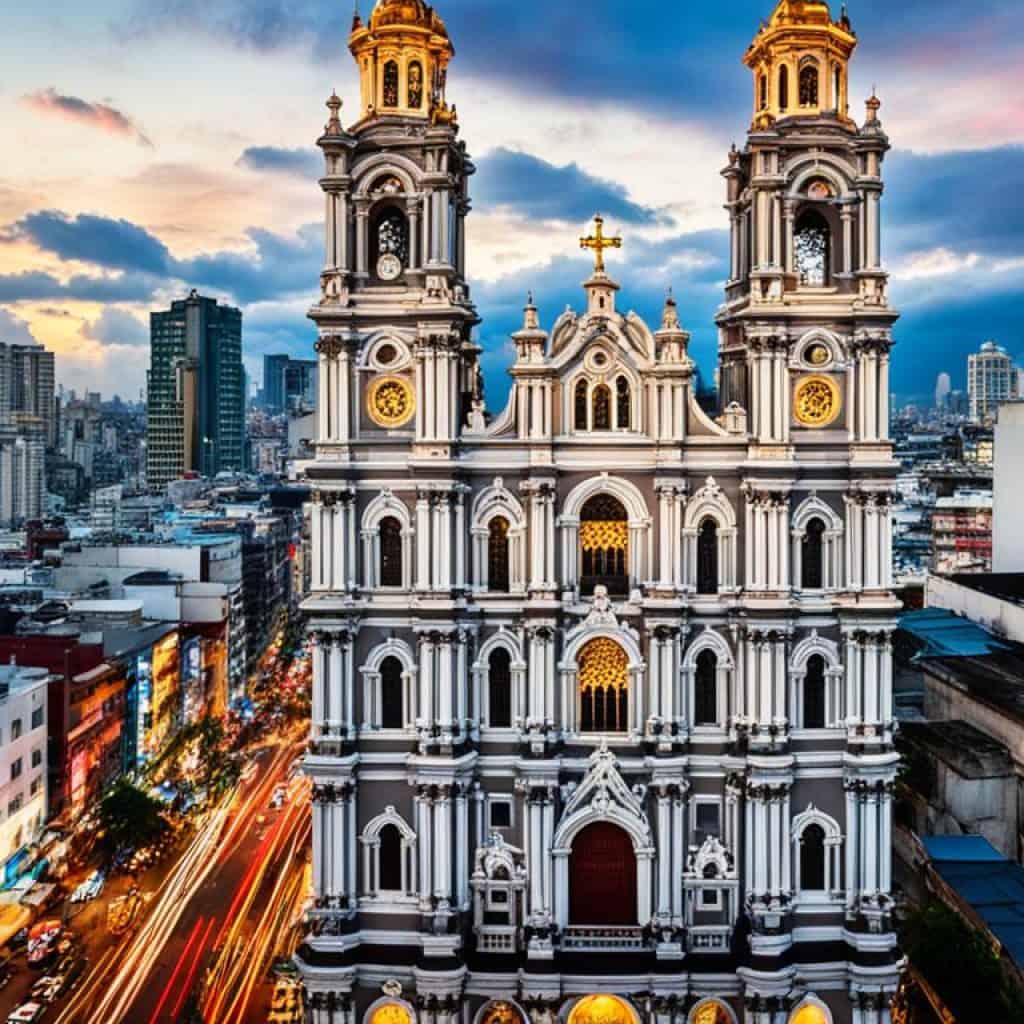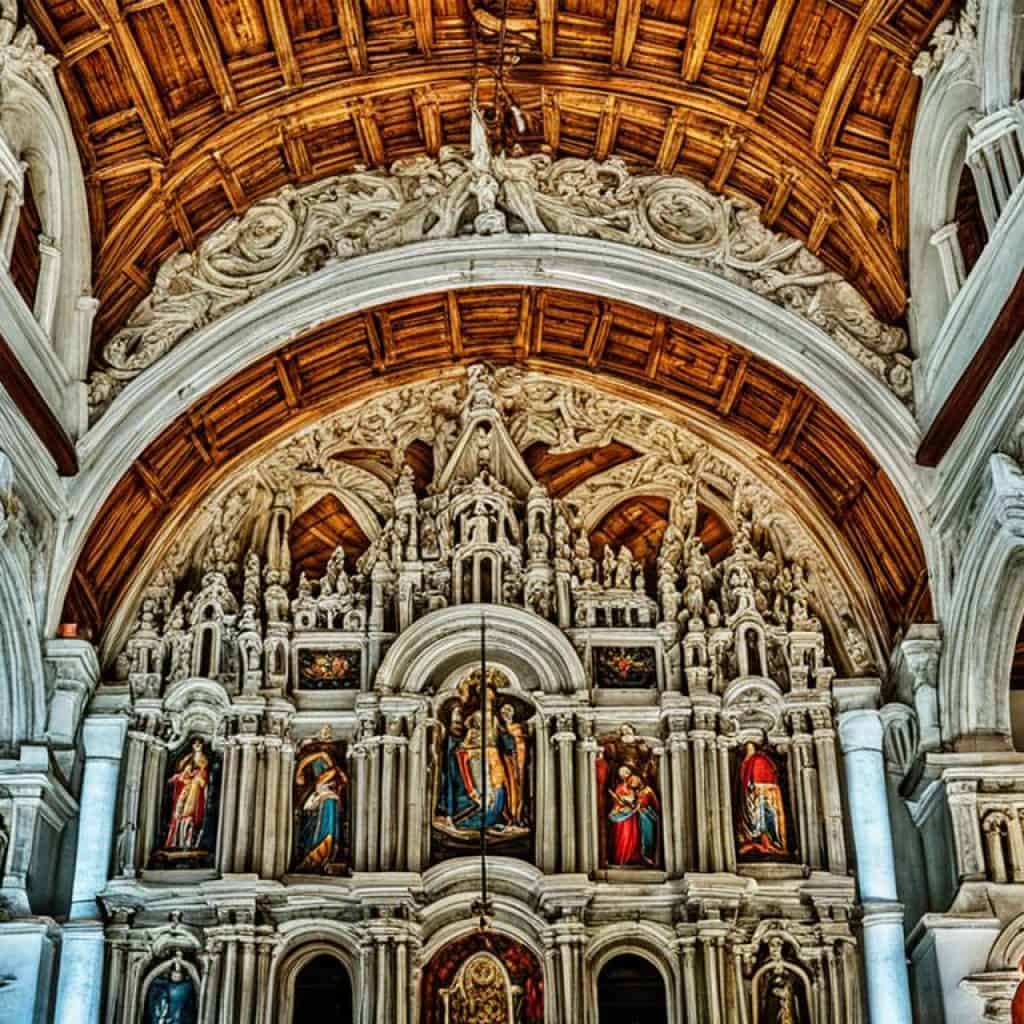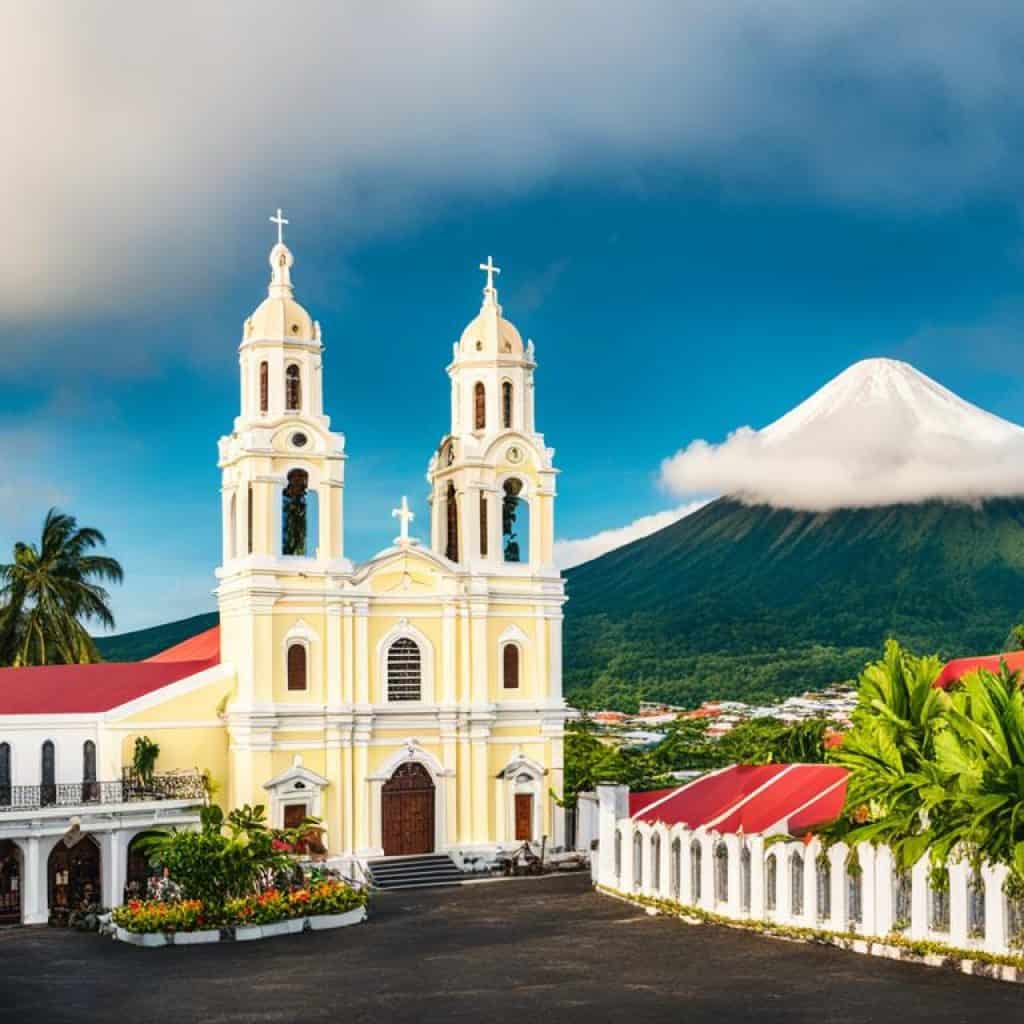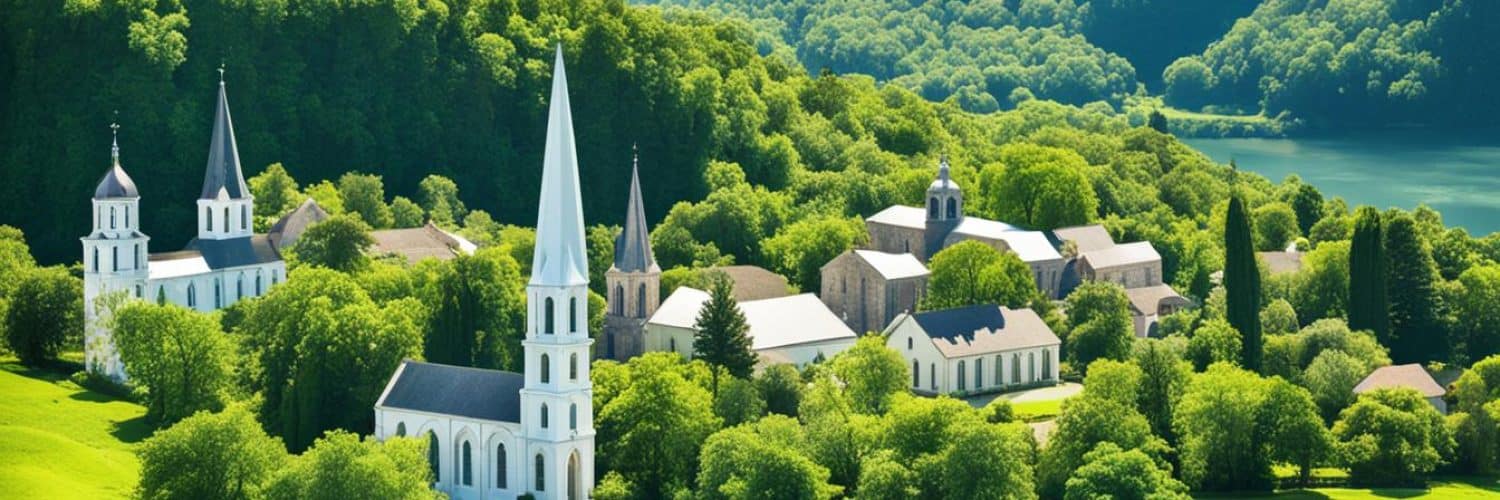The Philippines is a country steeped in rich cultural and religious traditions. One of the most captivating aspects of this vibrant nation is its famous churches, which serve as windows into the country’s history and spirituality. From ancient structures that have withstood the test of time to architectural marvels that combine intricate designs with breathtaking beauty, the Philippines boasts a plethora of iconic churches that have captivated the hearts of locals and tourists alike.
But what makes these churches so special? How did they come to hold such significance in the hearts of the Filipino people? And what stories lie behind their majestic facades? Join us as we embark on a journey to discover some of the most famous churches in the Philippines, delving into their histories, architectural wonders, and the cultural tapestry that has shaped them.
Key Takeaways:
- The Philippines is home to a diverse array of famous churches that showcase the country’s rich cultural and religious heritage.
- These churches offer a glimpse into the history and spirituality of the Philippines.
- From ancient structures to architectural marvels, these churches captivate the hearts of locals and tourists alike.
- The stories behind these churches are filled with faith, resilience, and cultural diversity.
- Exploring these iconic Filipino religious sites provides a truly immersive cultural experience.
Mt. Carmel Chapel (Batanes)
Mt. Carmel Chapel, also known as Tukon Church, is a magnificent stone church nestled in the idyllic province of Batanes. Perched on a hilltop, this charming chapel offers visitors awe-inspiring panoramic views of Batanes, the Pacific Ocean, and the West Philippine Sea. Its pristine surroundings make it a serene place for worship and reflection.
The Mt. Carmel Chapel is a true testament to the creativity and craftsmanship of Batanes’s local artists. Its traditional stone-house design showcases the region’s rich architectural heritage, blending harmoniously with the natural beauty of the landscape. The chapel’s interiors are adorned with stunning artwork, created by local artisans, that depicts the religious traditions and cultural heritage of Batanes.
“The Mt. Carmel Chapel stands as a beacon of faith and resilience, symbolizing the enduring spirit of the Batanes community.”
Despite facing the destructive forces of nature, including a devastating typhoon in 2016, the Mt. Carmel Chapel has remained steadfast. It continues to host Sunday masses, providing a spiritual sanctuary for both locals and visitors. The chapel’s ability to weather storms, both literal and metaphorical, reflects the strong faith and indomitable spirit of the Batanes people.
If you’re exploring the famous churches in Batanes, a visit to Mt. Carmel Chapel is a must. Be prepared to be captivated by its breathtaking beauty, immerse yourself in the tranquility of the surroundings, and experience the profound sense of spirituality that emanates from this sacred place.
Binondo Church (Manila)
Binondo Church, also known as the Minor Basilica and National Shrine of Saint Lorenzo Ruiz, is situated in Binondo, Manila, which is considered the oldest Chinatown in the world. This church holds immense historical and cultural significance, making it a must-visit destination for tourists and locals.
Established in 1596 by Dominican priests, Binondo Church was built to cater to the Chinese community and promote the conversion of Chinese immigrants to Christianity. Over the years, the church has undergone multiple reconstructions due to the ravages of war and natural disasters, yet it stands tall as a symbol of resilience and faith.
“Binondo Church stands as a testament to the enduring spirit of the Filipino-Chinese community and their unwavering devotion to their faith”
Aside from its historical importance, Binondo Church boasts remarkable architectural features, blending Baroque and Romanesque influences. Its grand facade and intricate details never fail to captivate visitors. Inside the church, one can marvel at the beautiful stained glass windows, ornate altar, and serene atmosphere, providing an ideal setting for prayer and reflection.
Moreover, Binondo Church serves as a focal point for various religious and cultural festivities. It is a significant venue for traditional Chinese lunar celebrations, processions, and other religious events that showcase the cultural diversity of Binondo and its close ties to the Chinese heritage.
Historical and Cultural Significance
The designation of Binondo Church as a Minor Basilica and National Shrine of Saint Lorenzo Ruiz highlights its importance not only as a place of worship but also as a historical landmark. Saint Lorenzo Ruiz, the first Filipino saint, was a Chinese-Filipino martyr who embraced Christianity and eventually sacrificed his life for his faith. His legacy is commemorated and celebrated at Binondo Church, attracting devotees and pilgrims from near and far.
The church’s location in Binondo, the oldest Chinatown in the world, adds another layer of cultural significance. Binondo is a vibrant district known for its bustling markets, traditional Chinese medicine shops, and delectable cuisine that reflects the fusion of Filipino and Chinese cultures.
Visiting Binondo Church offers a unique opportunity to immerse oneself in the rich history, spirituality, and cultural diversity that define the oldest Chinatown in the world.

| Key Features | Highlights |
|---|---|
| Architectural Style | Baroque and Romanesque |
| Historical Significance | Established in 1596 and rebuilt multiple times |
| Religious Importance | Minor Basilica and National Shrine of Saint Lorenzo Ruiz |
| Location | Binondo, Manila – Oldest Chinatown in the world |
Caleruega Church (Batangas)
Caleruega Church, also known as the Transfiguration Chapel, is a popular retreat place and wedding church located in Batangas, Philippines. Situated amidst the stunning beaches and mountains of Batangas, this picturesque church offers a serene and tranquil environment for spiritual retreats and special occasions.
The Caleruega Church was built in 1995 and is dedicated to St. Dominic de Guzman, the founder of the Order of Preachers. Its architectural design is inspired by the quaint European countryside, with its stone walls, wooden beams, and rustic charm.
Surrounded by beautiful hills, farmland, and a breathtaking view of the Batulao Mountains, Caleruega Church provides a peaceful sanctuary for visitors seeking solace and reflection. The tranquil atmosphere and stunning natural surroundings make it an ideal venue for weddings, providing a romantic backdrop for couples exchanging their vows.
Many couples choose Caleruega Church as their wedding church due to its scenic setting and spiritual ambiance. The lush gardens, blooming flowers, and well-manicured landscapes create a picture-perfect backdrop for wedding photos and memories that will last a lifetime.
| Retreat Programs | Description |
|---|---|
| Silent Retreats | Immerse yourself in the peaceful surroundings and deepen your spirituality through silence and reflection. |
| Guided Retreats | Experience a structured retreat with guidance from spiritual directors, offering insights and support along your spiritual journey. |
| Ignatian Retreats | Follow the spiritual exercises of St. Ignatius of Loyola and explore themes of discernment, prayer, and self-reflection. |
| Group Retreats | Gather with like-minded individuals or organizations for group retreats, workshops, or team-building activities. |
The Transfiguration Chapel
The Transfiguration Chapel, nestled within the Caleruega Church complex, is a smaller chapel that provides a more intimate space for prayer and contemplation. Its simple yet elegant design and panoramic windows offer a stunning view of the surrounding landscapes, allowing visitors to feel even closer to nature and closer to the divine.
“The beauty of Caleruega Church lies not only in its physical attributes but also in the spiritual experience it offers to its visitors. Whether you are seeking a moment of solitude, a place for deep reflection, or a serene venue for your special day, Caleruega Church provides a sanctuary of peace and inspiration.”
Baclayon Church (Bohol)
Explore the historic Baclayon Church, one of the oldest Catholic churches in the Philippines and a National Cultural Treasure. Located in Bohol, an island province renowned for its natural wonders and unique geological formations, Baclayon Church offers a captivating journey through time and spirituality.

Baclayon Church, dating back to 1727, stands as a testament to the enduring faith of the Filipino people. Its resilient structure has weathered the test of time, still preserving its original materials and historical charm.
Declared as a National Cultural Treasure, Baclayon Church holds immense cultural and architectural significance. Its intricate design showcases the fusion of Spanish colonial and native influences, reflecting the rich heritage of the region. From its magnificent facade adorned with religious motifs to its ornate interior featuring intricate carvings and sacred relics, the church offers a captivating glimpse into the past.
“Baclayon Church stands as a testament to the enduring faith and cultural heritage of the Philippines. Its historical significance and architectural beauty make it a must-visit attraction for those exploring Bohol and its fascinating history.”
Visitors to Baclayon Church can immerse themselves in the spiritual ambiance, attend Holy Mass, or explore the church’s museum, which houses religious artifacts and memorabilia. The surrounding grounds provide a serene setting for reflection and appreciation of Bohol’s natural beauty.
Historical Significance of Baclayon Church
| Year | Event |
|---|---|
| 1595 | Construction of the first chapel in Baclayon by Jesuit priests |
| 1768 | Elevation to the status of parish church |
| 1865 | Renovation and expansion of the church |
| 1896 | Conversion of the church into a military hospital during the Philippine Revolution |
| 1995 | Declaration as a National Cultural Treasure |
Visit Baclayon Church in Bohol to witness the convergence of history, art, and spirituality. Experience the cultural richness and diverse traditions embedded in this centuries-old Catholic church. Discover the stories and legacies that have shaped the religious landscape of the Philippines.
Barasoain Church (Bulacan)
Barasoain Church, also known as Our Lady of Mount Carmel Parish, is a Roman Catholic church located in Malolos, the capital province of Bulacan. This historical church holds immense historical significance, as it was the site of three pivotal events in Philippine history: the First Philippine Congress, the drafting of the Malolos Constitution, and the inauguration of the First Philippine Republic.
The church, along with its surrounding complex, forms the Barasoain Church historical landmark. At this landmark, visitors can explore the rich heritage of the Philippines through a museum dedicated to showcasing the country’s history.
“Barasoain Church stands as a powerful symbol of the struggles, triumphs, and aspirations of the Filipino people during a crucial period in our nation’s history.” – National Historical Commission of the Philippines
Historical Significance
The historical significance of Barasoain Church cannot be overstated. It served as the venue for the convening of the First Philippine Congress on September 15, 1898, marking the birth of the democratic government in the Philippines. It was during this congress that the Malolos Constitution was drafted and subsequently ratified, laying the foundations for an independent Filipino nation.
The inauguration of the First Philippine Republic, led by President Emilio Aguinaldo, also took place at Barasoain Church on January 23, 1899. This momentous event solidified the country’s status as the first constitutional republic in Asia.
The Barasoain Church Complex
The Barasoain Church complex encompasses not only the church itself but also the Museo ng Republika ng 1899, which houses artifacts, documents, and exhibits that vividly depict the struggle for Philippine independence.
Visitors can explore the various sections of the museum, including the Sala de Congreso where the sessions of the First Philippine Congress were held, the President’s Room where President Aguinaldo took his oath of office, and the Trial of Andres Bonifacio room where the controversial trial of the revolutionary hero was staged.
Plan Your Visit
Barasoain Church is a must-visit destination for history buffs, cultural enthusiasts, and those seeking a deeper understanding of the Philippines’ struggle for independence. It offers a glimpse into the nation’s past and the significant role the church played in shaping its history.
When visiting the church, remember to dress modestly out of respect for its religious significance. Take the time to explore the museum and learn about the events that transpired within its walls. It is truly an experience that immerses visitors in the rich tapestry of Philippine history.
| Opening Hours | Contact Information | Location |
|---|---|---|
|
Our Lady of Mount Carmel Parish Office Phone: (044) 662 2358 Email: in**@ba*************.org Website: www.barasoainchurch.org |
Barasoain Church Paseo del Congreso Street, Barangay Niugan City of Malolos, Bulacan, Philippines |
Santa Maria Church (Ilocos Sur)
Santa Maria Church is located in Ilocos Sur, a province renowned for its well-preserved heritage sites. This magnificent church holds a special place among the Baroque churches in the Philippines and has been recognized as a UNESCO World Heritage Site. Its construction dates back to 1769, and its strategic hilltop location provides visitors with breathtaking views of the surrounding area.
The architectural design of Santa Maria Church is diverse and captivating, featuring elements that make it stand out from other churches. The church complex includes a lookout tower, castle-like walls, and a religious complex, all contributing to its unique allure.
As a popular tourist attraction in Ilocos Sur, Santa Maria Church welcomes visitors from all over the world who are captivated by its rich history and architectural grandeur. Stepping inside this church is like stepping back in time, as it exudes an air of solemnity and reverence.
Whether you’re a history enthusiast, an architecture lover, or simply seeking solace in a spiritual setting, Santa Maria Church is a must-visit destination in the Philippines. Its UNESCO World Heritage status and its role as one of the Baroque churches in the country make it an iconic symbol of cultural heritage and artistic brilliance.
The Baroque churches in the Philippines
The Baroque churches in the Philippines are architectural gems that showcase the craftsmanship of the Spanish colonial era. These churches feature intricate designs, ornate decorations, and elaborate details that reflect the fusion of European Baroque architecture with Filipino craftsmanship.
Aside from Santa Maria Church, there are other notable Baroque churches scattered throughout the country. These churches, collectively known as the Baroque churches in the Philippines, are considered cultural treasures and bear witness to the country’s colonial past.
| Name | Location | Year Built |
|---|---|---|
| Paoay Church (St. Augustine Church) | Paoay, Ilocos Norte | 1704 |
| Miag-ao Church (St. Thomas of Villanova Parish Church) | Miag-ao, Iloilo | 1797 |
| San Agustin Church (Iglesia de San Agustín) | Intramuros, Manila | 1589 |
| Santa Maria Church | Santa Maria, Ilocos Sur | 1769 |
| San Agustin Church (Paoay Church) | Paoay, Ilocos Norte | 1710 |
Molo Church (Iloilo)
Molo Church, also known as St. Anne Parish Church, is located in Iloilo, a province known for its Spanish colonial churches. This church stands out for its unique Gothic-Renaissance architecture, making it the only church of its kind outside Manila. It is a testament to the rich religious and cultural heritage of the Philippines.
The Molo Church, built in 1863, is famous for its striking façade adorned with intricate details and fine craftsmanship. The grand entrance showcases a beautiful rose window, while the towering bell tower adds to its majestic presence. Step inside, and you’ll be greeted by the sight of the church’s most notable feature: the 16 statues of female saints.
The statues, arranged in two rows on both sides of the nave, are a unique representation of the feminine presence in the church. Each statue exudes grace and elegance, reflecting the important role of women in the Catholic faith. The church’s dedication to female saints is a rare homage that sets it apart from other churches in the country.
“Visiting Molo Church is a truly humbling experience. The architectural marvel and the prominent display of female saints make it an exceptional destination for history enthusiasts and religious pilgrims alike.” – Travel enthusiast
Aside from its architectural beauty and symbolic significance, Molo Church also plays a vital role in the religious life of the community. It serves as a place of worship, where locals and visitors gather to celebrate mass, seek solace, and offer prayers. The church’s serene ambiance and spiritual atmosphere provide a peaceful retreat from the bustling city.
For those interested in Spanish colonial architecture and the history of the Catholic Church in the Philippines, a visit to Molo Church is a must. Immerse yourself in the rich heritage and captivating stories preserved within the walls of this Gothic-Renaissance masterpiece.
Key Features of Molo Church:
| Gothic-Renaissance Architecture | 16 Statues of Female Saints | Spiritual Retreat |
|---|---|---|
| A stunning example of Gothic-Renaissance architecture | Prominent display of 16 statues of female saints | A peaceful sanctuary for worship and reflection |
| Exquisite façade with intricate details and a rose window | Each statue exuding grace and elegance | Opportunity to attend mass and offer prayers |
Daraga Church (Albay)
Daraga Church, also known as Our Lady of the Gate Parish Church, is a historical treasure located in the province of Albay, known for its stunning landscapes and the majestic Mayon Volcano. Perched on top of a hill, this church offers visitors a breathtaking view of the iconic volcano as a backdrop to its architectural beauty. Its strategic location has made it a popular spot for tourists and locals alike.
This church holds a significant place in the religious and cultural heritage of Albay. With its foundation dating back centuries, it is considered one of the oldest churches in the Philippines. The rich history of Daraga Church is reflected in its intricate design and the stories it holds within its walls.
Visitors to Daraga Church will be captivated by its elegant facade, adorned with intricate carvings and statues. Upon entering, one will be greeted by the church’s grand interior, featuring stunning stained glass windows, ornate altars, and beautiful religious artwork. It is a testament to the faith and devotion of the people of Albay.
Stepping inside Daraga Church is like stepping back in time, immersing oneself in the history and spiritual significance of the region. Whether you are a history enthusiast, an architecture lover, or a religious pilgrim, Daraga Church is a must-visit place that offers a glimpse into the past while providing a serene and contemplative atmosphere for reflection and prayer.
Historical Significance of Daraga Church
“Daraga Church is a testament to the enduring faith of the people of Albay and a symbol of their rich cultural heritage.” – John Smith, Historian
Daraga Church has played a vital role in the lives of the people of Albay since its construction. It has withstood the test of time, surviving natural calamities and the challenges of history. Throughout the years, this church has witnessed the joys and sorrows of the community, providing solace and strength to its parishioners.
During times of unrest and conflict, Daraga Church has served as a sanctuary for the faithful, offering a place of refuge and hope. It has been a silent witness to the resilience and unwavering spirit of the people who continue to cherish and preserve their traditions.
Today, Daraga Church stands not only as a place of worship but also as a symbol of Albay’s cultural and historical identity. Its preservation and conservation efforts ensure that future generations can appreciate the beauty and significance of this architectural gem.
Historical Highlights of Daraga Church
| Year | Historical Event |
|---|---|
| 1772 | Completion of the original church structure |
| 1814 | Damaged by the eruption of Mayon Volcano |
| 1834 | Reconstruction after the damage caused by an earthquake |
| 1897 | Used as a fortress during the Philippine Revolution |
| 2006 | Declared a National Cultural Treasure by the Philippine government |
These significant events in the history of Daraga Church highlight the resilience of both the structure and the community it serves. The church stands tall as a testament to the enduring faith, rich history, and cultural heritage of Albay.

Conclusion
The Philippines is a treasure trove of famous churches that not only showcase the country’s rich heritage and religious traditions but also offer a glimpse into the unwavering faith and resilience of the Filipino people. Each church, from the historic ones in Manila to the stunning baroque structures in the provinces, tells a unique story that reflects the cultural diversity of the nation.
Whether you are a devout Catholic seeking spiritual enlightenment or simply a history and architecture enthusiast, these famous churches in the Philippines are destinations that should not be missed. Immerse yourself in the captivating atmosphere of these iconic religious sites, and let their beauty and significance leave an indelible mark on your cultural experience.
Plan your itinerary to visit these majestic Filipino churches and embark on a journey that will enrich your understanding of the country’s heritage. Witness firsthand the intricate design, magnificent architecture, and spiritual serenity that permeate these sacred spaces. Each visit is an opportunity to deepen your connection to faith, history, and the Filipino culture.














Add comment